As soon as I started looking round the garden to see what sort of foliage I could photograph, it was obvious from all the new shoots that there were, that most, but not all the photos would be of the new foliage that was bursting forth in the garden. I shouldn’t have been surprised, because we have had a very mild winter so far with only a couple of little frosts, I just hope that we don’t get some arctic weather in March that will then burn all the new shoots. I’m starting with some fennel shoots just outside the back door.
This is a seedling of the parent plant, the parent seems to have died, can’t see any shoots anywhere near where it used to be.
All the Hydrangea bushes are showing signs of life.
I must finish cutting back all the buddlejas, only a few done so far.
Not up very far yet, but the burgundy shoots of Paeony mlokosewitschii echo the burgundy on the back of the hellebore petals.
All the way down the front drive are some variegated box plants. These have been grown from cuttings given to me by a friend. they had their first cut the other day, we are trying to train them into cubes this time as I have enough box balls!
The front hedge, under the kitchen window is Lonicera pileata, all grown from one plant and then cuttings taken years ago. The cone in the background is Lonicera Baggesen’s Gold ( not very gold at the moment, when the new growth comes it will be once more) and to the left you can see some of the box balls in the rose garden.
Tulips are up in the zinc bath where I planted them last year, yes, I know, weeding to do!
I have been growing yew seedlings that I have found round the garden, in pots, so that one day we can have a yew hedge somewhere. They are almost big enough to plant out now, but I think I will wait until the garden dries out a bit more, as they don’t like the wet.
Up till now I have been taking photos from the paths, but now I decided to squelch round the garden to take the rest. The garden is still so very soggy, even though we haven’t had any rain now for a few days. The first plant with lovely foliage was the cardoon in the border by the field.
Further up the field border is an old plant of Phlomis fruiticosa, maybe I ought to start afresh with some cuttings, it sprouts back quickly though when it is cut right back when it gets too woody and leggy.
This is what happens when I don’t go up to the top of the garden, the clematis are in desperate need of cutting back. The clematis on the pergola by the field are all viticella types, which means they all get cut down to about 2ft, all this new growth will have to go very soon.
Roses on the pergola also need cutting back, lovely new growth will have to go.
Acanthus mollis, near the pond area, is still looking very lush, I have never known it to be this good all winter, must be the mild weather.
Hemerocallis foliage is everywhere, looking very fresh and spring like. I spy a buttercup whose days are numbered!
There are clumps of Arum italicum marmoratum under most of the trees and shrubs, where the blackbirds deposit the seed.
In the border outside the back door is Libertia peregrinans which is slowly spreading and contrasts with the flowers nearby in the summer.
Colchicum foliage is springing up, this was my original clump of 3 bulbs, but each year now I move some to spread around the garden. I move them when the foliage is dying down so that they are in place long before they start flowering.
It might be only plain old montbretia, but the fresh apple green sword shaped leaves make me think that spring can’t be far away.
I am amazed at how far on all the alliums are, if they carry on at this rate they’ll be flowering in March!
Heuchera Lime Marmalade is looking very fresh and spring like.
In the woodland, cyclamen hederifolium is making a lovely patterned carpet under some rhododendrons, the ants are working hard spreading the seed for me!
English bluebells at the end of the woodland. Any Spanish ones that pop up are dug up and given away as I don’t want them hybridising with the English ones. Unfortunately the previous people planted the Spanish ones in the woodland.
They don’t look much now, but this is the beginnings of my drift of Fritillaria meleagris which I will be protecting from the pheasant this year after all the damage he did to the buds and flowers last year!
Still in the woodland, the cowslips have been seeding into the bark chipping path. as well as the odd little crocus. The bark path seems to be a good nursery bed for lots of seedlings.
In the gravel garden at the back Euphorbia melliferra and Pittosporum Irene Patterson contrast nicely and they are underplanted with……
…..Ophiopogon planiscapus nigrescens.
And lastly, still in the gravel garden, is Phormium Yellow Wave, gradually getting back to the size it was in 2010. I thought I had lost it in the bad winter we had then, it struggled for a couple of years, but now seems to have decided to stay, thank goodness.
Thanks for your company while I squelched round the garden, thanks too must go to Christina for hosting GBFD once more, do pay her a visit to see more foliage from around the world.



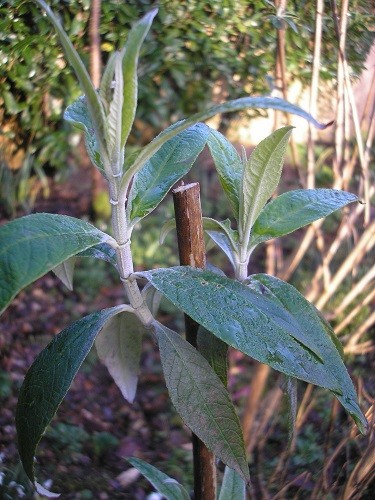
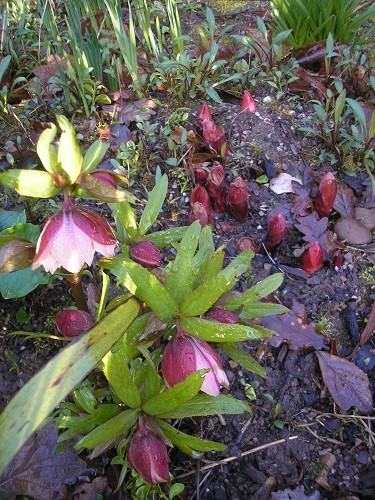



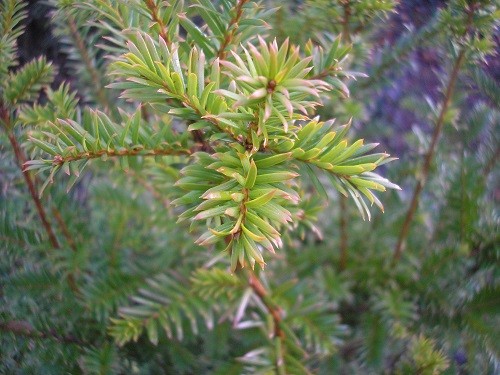
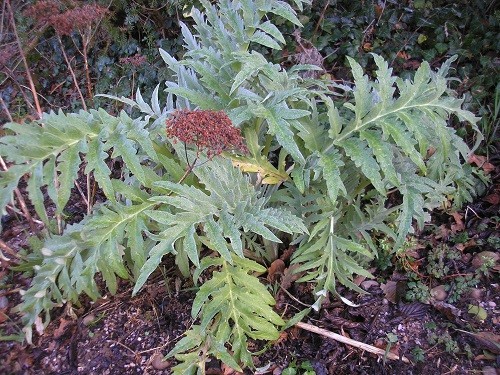
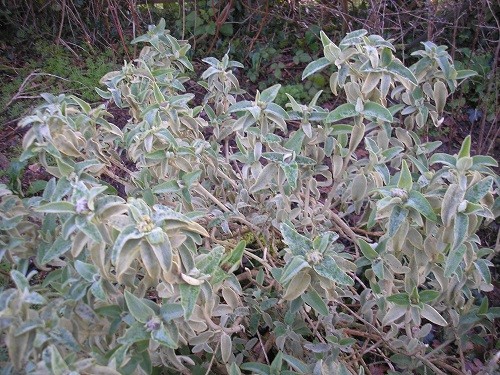





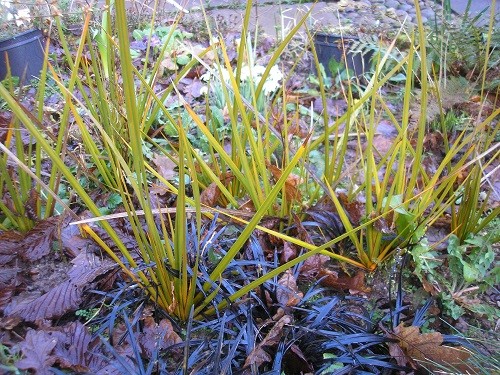

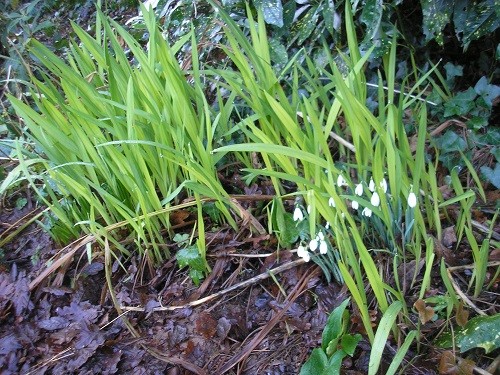

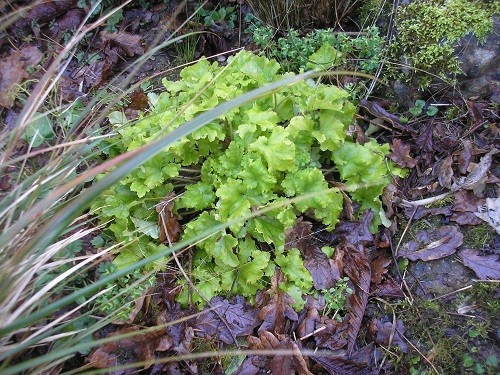


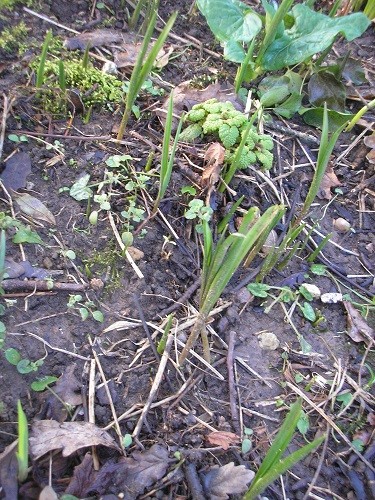

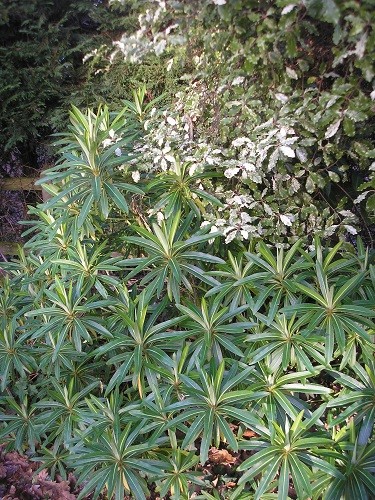
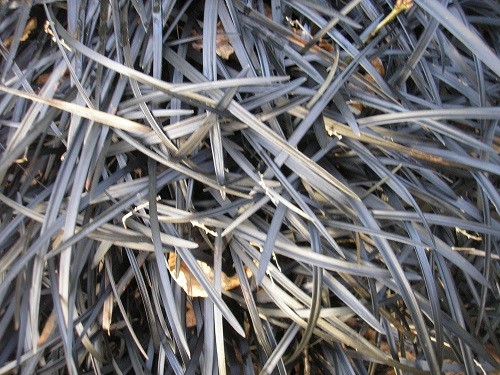

Where to start Pauline? Firstly thank you for joining in GBFD again this month with such a wonderful example of the beauty of foliage in your garden. I was interested in the hedge in front of the kitchen, I don’t remember seeing it before, I like the layout of the space very much. I planted a couple of Lonicera last autumn to replace the large box balls that died in the drought so I hope they will grow as well as yours.
Yes Christina, you have seen it a few times, but photographed from the other end! I’m sure your Lonicera will grow as well as mine, the only downside is that it needs trimming about 3 times to the box balls once a year! I found that lowers branches rooted themselves, that was how I got all my cuttings. The blackbirds here make nests in it, the bees love the tiny flowers and then in the autumn it has purple berries which are again eaten by the blackbirds, so very wildlife friendly!
Paeony mlokosewitschii is one of my favourite plants.
I too have many Spanish bluebells, planted by our predecessors. Each year I dig up tons of the damn things, but don’t they go deep! Almost inevitably I’ll miss some bulbs and even though they’ve lost all their foliage they still come back as strong the following year.
It’s lovely to see all the new Spring growth. Won’t be long now.
Yes Jessica, the Spanish bluebells do go very deep, it can be quite a problem to get rid of them. The garden and the birds are telling me that it won’t be long till spring !
Wow! You have so much coming up, it is so exciting. I always look forward to the nice fat red buds of Molly the Witch. They are lovely.
I have given up on trying to get rid of my Spanish bluebells they are everywhere. Someone must have planted them here years ago.
That’s a very smart Phormium. Does it get enormous?
Molly the Witch Chloris, looks wonderful at all stages of developement, don’t you think? Such a super plant.
Spanish bluebells must have been planted everywhere and now we’re all trying to get rid of them, English ones are so much nicer!
The phormium doesn’t grow much taller than it is now, about 3 feet, but if it grows back to what it was before our hard winter, it will eventually be about 6 ft wide.
I can’t believe how much growth some of your perennials are putting on Pauline. Look how fat Molly’s shoots are and they do look wonderful with the hellebore.
The Pittosporum and Euphorbia make a lovely combo. I don’t think I noticed the Fritilaria showing above the soil, I must check them out tomorrow – no pheasants here thankfully!
The colour of Molly’s shoots is amazing isn’t it Angie, it was pure coincidence that the hellebore picked up the burgundy of the peony. Some of the fritillaries have been up for a while now, with more coming up each day, the pheasant is strutting about with his harem, I just hope they leave the fritillaries alone this year!
That hellebore with ‘Molly’ is a wonderful piece of happenstance Pauline. And so many other glorious things too. I like your box cube, and the euphorbia with the pittosporum. Good luck with the fritillaries this year, no sign of any of mine popping up where I planted bulbs in the grass, but I have since read that it is better to do as with snowdrops, and plant “in the green”. I’m rather glad that there are no native bluebells close by, I inherited a huge number of the Spanish kind, and knowing how hard they are to dig up took the decision early on to just sit back and enjoy them.
If I didn’t have any English bluebells Janet, I too would be happy to sit back and enjoy the Spanish ones like you, but I’m afraid they have to go. The fritillaries I started off with were just a small packet of bulbs, so maybe yours will still come, they do look very like grass when they first come through!
Your post made me think of all the things I could have included in mine, Pauline – although I did spend a lot of time just rambling about after I had taken the photos. I’d like to think that most things would still be OK with a touch of frost – hope so! I realised I had left various tulips in pots and have no idea whether they will overwinter, although I expect the species ones to – were yours in the zinc bath just from last year? I need to look into this Molly the Witch peony that everyone raves about – oh and interesting to see those hedges as I don’t remember seeing that view before either. Hope the squelchiness is soon over….
Yes Cathy, my tulips were just left in the zinc bath from last year, I’m hoping they will all come up. Molly the Witch is a peony like no other, she flowers much earlier than the others to start with, and is a beautiful yellow/cream colour. She has taken quite a long time to reach a decent size, but now I look forward to it flowering every year.
We hope that we can soon start work on the garden again, it’s so frustrating!
I like your view across the Lonicera hedge. There is so much going on in your garden Pauline – good to see all that greenery! Some things are poking their heads up here too, but removing the protective winter mulch will have to wait a few more days to be on the safe side.
Thanks Cathy, the early morning sunshine just caught the hedge at the right angle. I think you have had it much colder than we have, I just hope that we don’t have freezing weather in March as we sometimes do!
Such a tremendous amount of new growth Pauline. Everything is looking so fine–really do like that patch of cyclamen hederifolium. Susie
Everything thinks spring has arrived Susie, I hope they don’t get a shock! I have to remember that the patch of cyclamen is there in the summer before they start flowering, it looks as though there is a bare patch and I have to stop myself planting anything in the same spot once the leaves have died down.
Enjoyed the narrative and the lovely photos. Blessings, Natalie 🙂
Thank you Natalie, glad you enjoyed your wander round the garden with me.
It certainly looks like spring in your garden Pauline! I particularly like your cardoon.
As for bluebells, if you want any in our cold Ontario climate, you have to rely on the Spanish one. In the two gardens I have had here, the English bluebells did not survive the winter but the Spanish one did.
I hope the plants don’t get a shock Alain, but the forecasters say that the weather is going to get colder this week! It’s strange isn’t it that Spanish bluebells can survive your cold winters or is it your hot summers that the English bluebells don’t like? I have been over there in one of your hot summers, I don’t think I would have survived for long!
So many things to admire. I really love the variegated box cubes. It must be such fun to prowl around with the camera and find so many lovely things. You are a couple weeks ahead of us I believe.
We have had a very mild winter Marian which has brought a few plants on earlier than usual.The box cubes have a bit of fattening up to do, they are a bit thin at the moment! It was nice to be able to wander round the garden once more, it seems such a long time since we were last able to do that without any rain.
True, there’s really a lot going on in your garden, Pauline, and things are already so big – look at these alliums! E. mellifera is so gorgeous – It’s time I got one. I very much like the view of your hedge and topiary.
Annette, the Alliums are still growing, getting bigger and bigger every day! Clipped shapes in the garden certainly add interest in the winter, in the summer, the box balls get hidden by all the roses, they come into their own at this time of year. The honey perfume from Euphorbia mellifera follows me round the garden on the breeze in May, it travels such a long way. If you can find one, do get it, you won’t regret it!
very refreshing to take photos from a different angle, so easy to get stuck in a rut just taking photos from the path. I’m always amazed and so impressed at the number of different plants you have. The garden doesn’t seem to have minded all the rain …
The plants all seem happy Catmint, in spite of all the rain we have been having. The garden is starting to dry out a bit now that the rain has stopped for a few days, more on the way though. With having so many different areas, woodland, boggy, sunny and shady, we are able to have different plants that suit those habitats. I’m just so pleased to find so many plants that seem to enjoy our underlying heavy clay!
I’m so glad to see spring going your way. Things look nice but I’m sure they could do with a nice drying out.
It’s nice to hear how you’ve grown so many of your plants from cuttings and nursed on seedlings, I think some newer gardeners think if they want three of something, they need to buy three, and don’t realize how patience and some knowledge can pay off.
Here’s to more sunshine and warmth, and no late frosts!
We are gradually drying out Frank, thanks very much.
I think gardening teaches us all patience, it is so wonderful to see a seed developing or a cutting that has started to grow. Having decided that I like my garden with drifts of various plants at different times, the only way is to grow them from seed.
In the past, we have quite often had frosts in March and April, we’re hoping this year will be different!